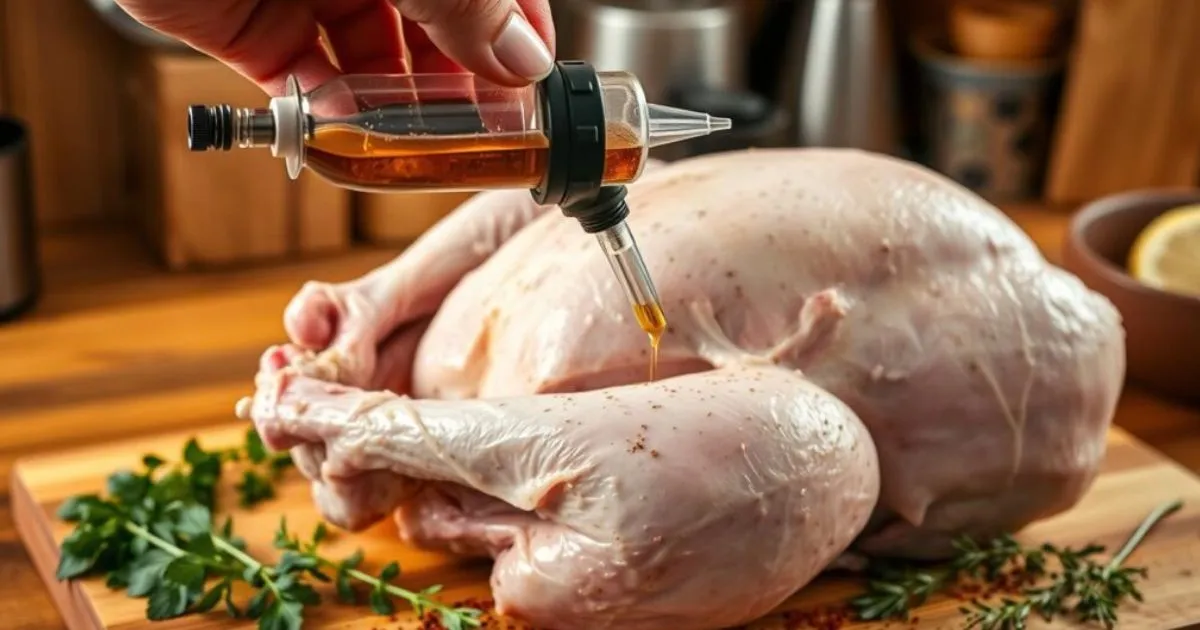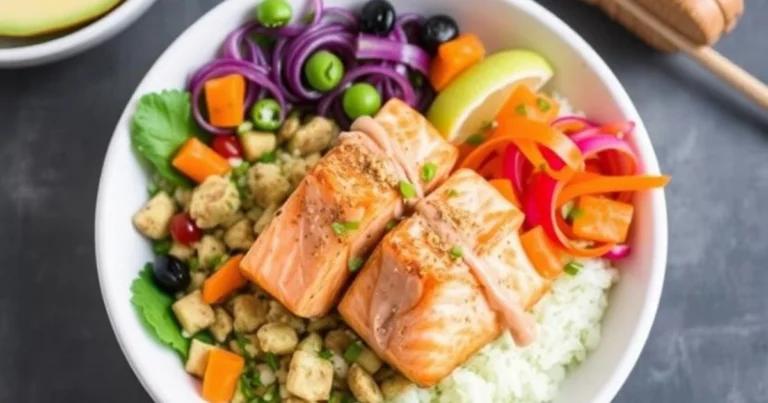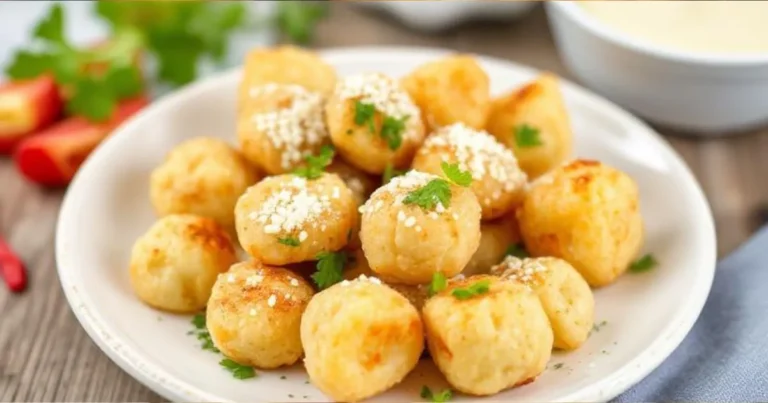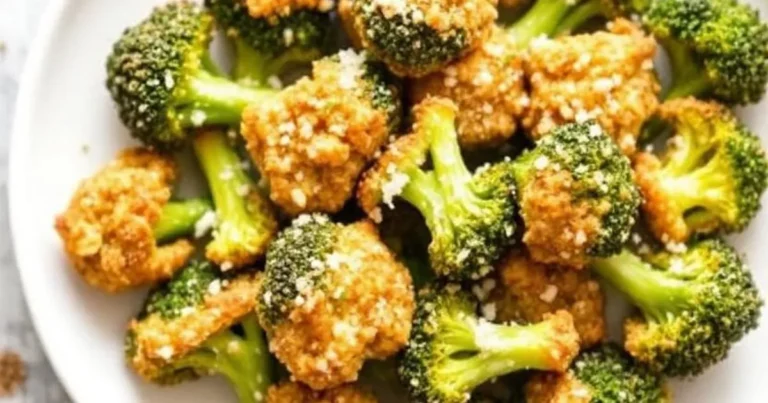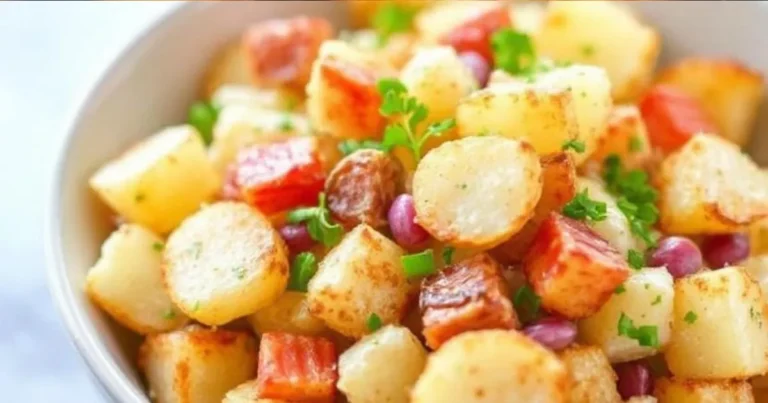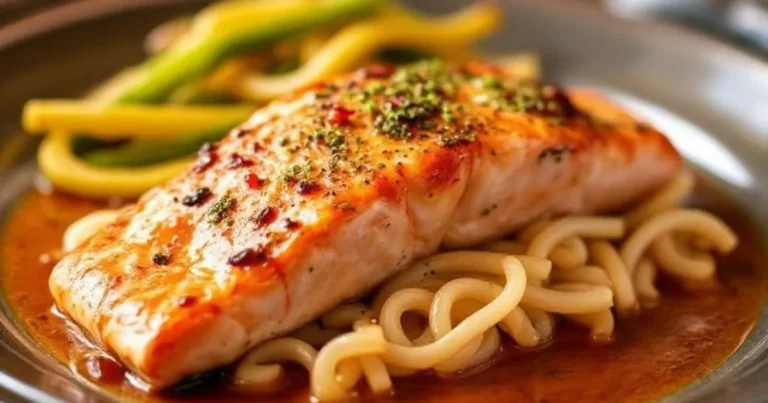The Best Techniques for Injecting Turkey Marinade Like a Pro
Table of Contents

Every Thanksgiving, I remember watching my grandmother transform an ordinary turkey into a culinary masterpiece. She used her secret injecting turkey marinade technique. Her hands moved with precision, carefully infusing flavor into every fiber of the bird.
Injecting turkey marinade isn’t just a cooking method—it’s an art form. It elevates your holiday centerpiece from bland to grand. Professional chefs and home cooks alike know it can dramatically improve meat moisture, tenderness, and flavor depth.
Whether you’re a seasoned cook or a kitchen novice, mastering turkey injection marinade will change your approach to preparing poultry. This guide will walk you through professional techniques. They guarantee a juicy, flavorful turkey every single time.
Key Takeaways
- Injecting marinade enhances meat moisture and flavor
- Proper technique prevents dry, tasteless turkey
- Professional tools make a significant difference
- Different injection points target specific meat sections
- Temperature and timing are crucial for perfect results
Essential Equipment for Turkey Injection
Preparing the perfect turkey is more than just a recipe. Your turkey marinade injector is key to making it special. Knowing the right tools can greatly improve your holiday cooking.
Types of Marinade Injectors
Choosing a turkey injector set can be a bit tricky. You’ll find several main types:
- Stainless Steel Manual Injectors
- Plastic Barrel Injectors
- Professional Grade Commercial Injectors
- Electric Powered Injection Systems
Needle Sizes and Their Uses
| Needle Size | Meat Type | Best For |
|---|---|---|
| 1/8 inch | Chicken | Delicate meats, minimal damage |
| 1/4 inch | Turkey Breast | Even marinade distribution |
| 1/2 inch | Large Turkeys | Deep tissue penetration |
Maintenance and Cleaning Tools
Keeping your turkey injector set clean is crucial for food safety and longevity. Always clean it well after each use with:
- Hot, soapy water
- Bottle brush for narrow parts
- Sterilizing solutions
- Drying rack for complete air drying
“A clean injector is a chef’s best friend.” – Professional Chef Recommendation
Investing in a high-quality turkey marinade injector will elevate your cooking game and impress your guests with incredibly flavorful, juicy turkey.
Understanding the Science Behind Injecting Turkey Marinade
Injecting turkey flavor is more than a cooking trick. It’s a science that changes how your meat tastes and feels. When you use a marinade injector, you make tiny paths for flavor and tenderizers to get deep into the turkey’s fibers.
The science of injecting turkey tenderizer includes a few main points:
- Protein breakdown through enzymatic action
- Moisture retention at cellular levels
- Flavor distribution beyond surface seasoning
Marinades have special parts that work with meat proteins:
- Acidic ingredients break down tough muscle structures
- Salt pulls in water molecules
- Enzymes from things like pineapple or papaya make meat softer
“The key to perfect turkey lies in understanding how marinades interact with meat at a molecular level.” – Culinary Science Institute
By injecting marinade, you get even flavor and softer meat. This method lets seasonings reach places that rubbing can’t. So, your turkey tastes better and is juicier.
Basic Marinade Recipe Components for Juicy Turkey
Making the perfect meat injection marinade is an art. It can turn your turkey into something truly special. Knowing the key ingredients will help you make a flavorful bird that will wow your guests.
Liquid Base Foundation
Your marinade starts with a good liquid base. The right base helps flavors soak in and keeps the meat moist. Here are some top choices:
- Chicken or turkey stock
- Melted butter
- White wine
- Apple juice
- Olive oil
Flavor Enhancers and Seasonings
Choosing the right seasonings is crucial for your turkey brine. These seasonings should match your liquid base. Some top picks include:
- Kosher salt
- Fresh herbs (rosemary, thyme)
- Garlic powder
- Black pepper
- Paprika
“The secret to an incredible turkey is not just in the cooking, but in the preparation of your marinade.” – Professional Chef
Brining Solutions for Maximum Moisture
A good brining solution can make your turkey incredibly juicy. You want a mix that goes deep into the meat but doesn’t overpower it.
Pro tip: Always strain your marinade before using it. This stops clogs in your injector needle. It also helps flavors spread evenly.
Preparing Your Turkey for Injection
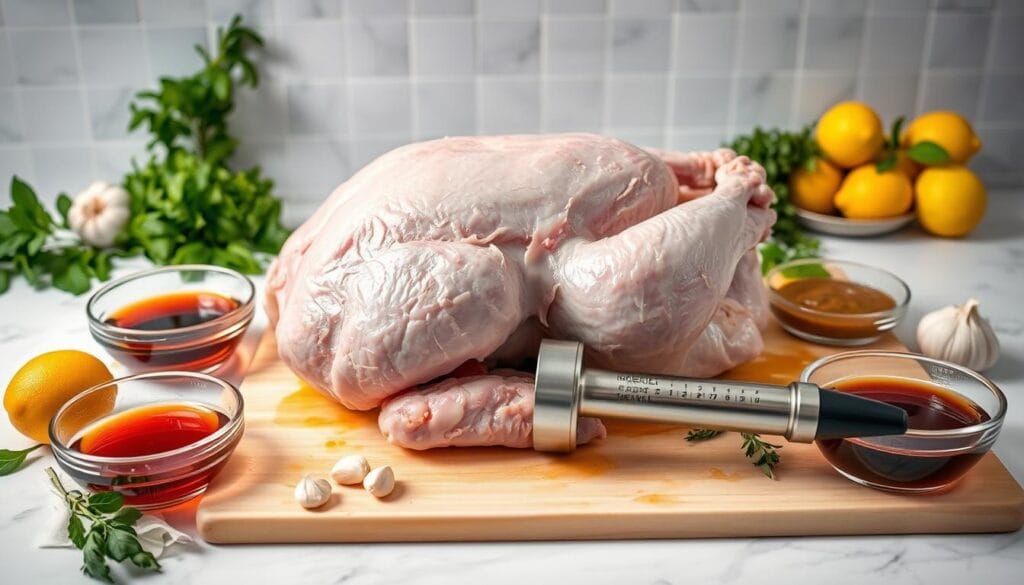
To get your turkey ready for marinade injection, you need to prepare it carefully. Your aim is to make sure it absorbs flavors well and stays juicy.
First, pick a high-quality turkey that’s fully thawed. If it’s frozen, thaw it in the fridge. This can take a few days, depending on the turkey’s size. Never thaw it with warm water or leave it at room temperature, as this can lead to bacterial growth.
“Proper preparation is the secret to exceptional turkey flavor” – Professional Chef Recommendation
Before you start injecting marinade, follow these important steps:
- Remove giblets and neck from turkey cavity
- Pat the turkey completely dry with paper towels
- Place turkey on a clean, spacious work surface
- Ensure turkey is at consistent temperature (40-45°F)
Here are the key tools you’ll need for successful turkey injection:
| Equipment | Purpose | Recommended Type |
|---|---|---|
| Marinade Injector | Distribute marinade evenly | Stainless steel, large-barrel injector |
| Cutting Board | Clean work surface | Large, non-slip plastic board |
| Paper Towels | Pat turkey dry | Absorbent, lint-free towels |
Pro tip: Always handle raw poultry with care to prevent cross-contamination. Use separate cutting boards and wash hands thoroughly between steps.
Strategic Injection Points for Maximum Flavor
Mastering the art of injecting turkey juices is all about precision and where you place it. Your turkey injection marinade can turn an ordinary turkey into a culinary masterpiece if done right.
Knowing the best places to inject flavor is key to even distribution. Different parts of the turkey soak up marinade in different ways. This makes your approach very important for great taste.
Breast Meat Injection Techniques
The turkey breast can dry out easily. Strategic injection helps keep it moist and flavorful. Here are some key techniques:
- Inject at multiple angles to ensure even distribution
- Use a thin needle to prevent meat tearing
- Target the thickest parts of the breast muscle
Dark Meat Targeting
Dark meat needs a special approach for turkey injection marinade. These areas can handle more intense flavors and need deeper penetration:
- Focus on thigh and leg muscle groups
- Use slightly larger needle openings
- Inject at various depths to maximize flavor absorption
Multiple Injection Patterns
Professional chefs suggest a grid-like pattern for injecting turkey juices. This method ensures flavor is spread evenly:
| Body Part | Injection Frequency | Needle Angle |
|---|---|---|
| Breast | Every 2 inches | 45-degree angle |
| Thighs | Every 1.5 inches | 30-degree angle |
| Legs | Every 2 inches | Varied angles |
“A well-injected turkey is like a symphony of flavor, with each note perfectly placed.” – Culinary Expert
By following these strategic injection points, you’ll make sure your turkey is not just cooked. It will be transformed into a memorable dining experience.
Common Mistakes to Avoid When Injecting Turkey
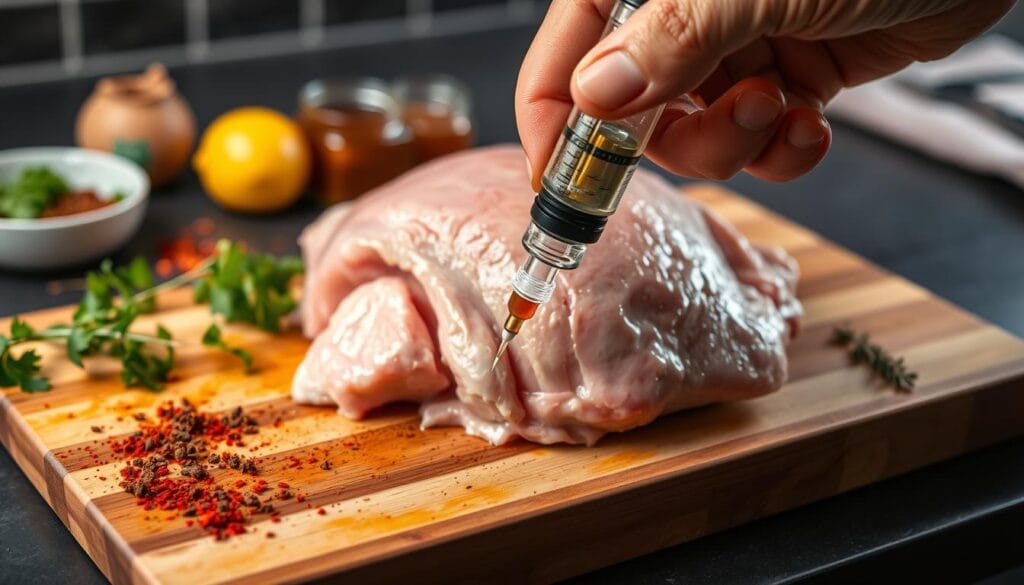
Injecting turkey marinade is an art that needs skill and care. Many home cooks make mistakes that can ruin the turkey’s taste and texture.
When using a turkey marinade injector, being precise is crucial. Here are some common mistakes to avoid:
- Over-injecting the turkey, which can cause liquid to leak out during cooking
- Using an incorrectly sized needle for your specific cut of meat
- Injecting too close to the skin, creating unsightly bubbles
- Failing to distribute marinade evenly throughout the turkey
Pro tip: Always test your turkey marinade injector before the big cooking day. Practice on a smaller piece of meat to understand the right technique and pressure.
“The difference between a good and great turkey is in the details of injection.” – Professional Chef
Some key mistakes that can ruin your turkey injection process include:
- Using cold marinade, which doesn’t penetrate meat effectively
- Pushing the injector too forcefully, causing meat to tear
- Neglecting to clean your turkey marinade injector thoroughly between uses
Remember, gentle and strategic injecting will help you achieve a perfectly seasoned, juicy turkey that will impress your guests.
Professional Tips for Even Marinade Distribution
Mastering the art of injecting turkey flavor needs precision and technique. When making your meat injection marinade, knowing how to distribute it well can turn a simple turkey into a culinary masterpiece.
Professional chefs say that successful turkey injection is more than just pushing liquid into the meat. It’s about strategic application and careful technique.
Depth Control Methods
Getting perfect marinade penetration requires careful needle placement. Here are some expert tips:
- Insert the injection needle at a 45-degree angle
- Aim for mid-muscle tissue depth
- Move slowly to prevent meat tearing
- Use gentle, consistent pressure
Temperature Considerations
Temperature is key in meat injection marinade effectiveness. Your turkey and marinade need careful management:
| Marinade Temperature | Recommended Action |
|---|---|
| Below 40°F | Warm slightly before injection |
| Above 70°F | Chill before use to prevent bacterial growth |
Timing Guidelines
Timing is crucial in your injecting turkey flavor technique. Follow these professional tips:
- Inject 12-24 hours before cooking
- Allow marinade to distribute evenly
- Store turkey in refrigerator during resting period
“Patience and precision are the secret ingredients to perfectly injected turkey.” – Professional Chef Recommendation
Pro tip: Always clean your injection needle thoroughly between uses to maintain food safety and prevent cross-contamination.
Flavor Combinations and Marinade Recipes
To make your turkey injection marinade stand out, think outside the box. The right brine can turn a simple holiday meal into a feast everyone will remember. It’s all about the flavors you choose.
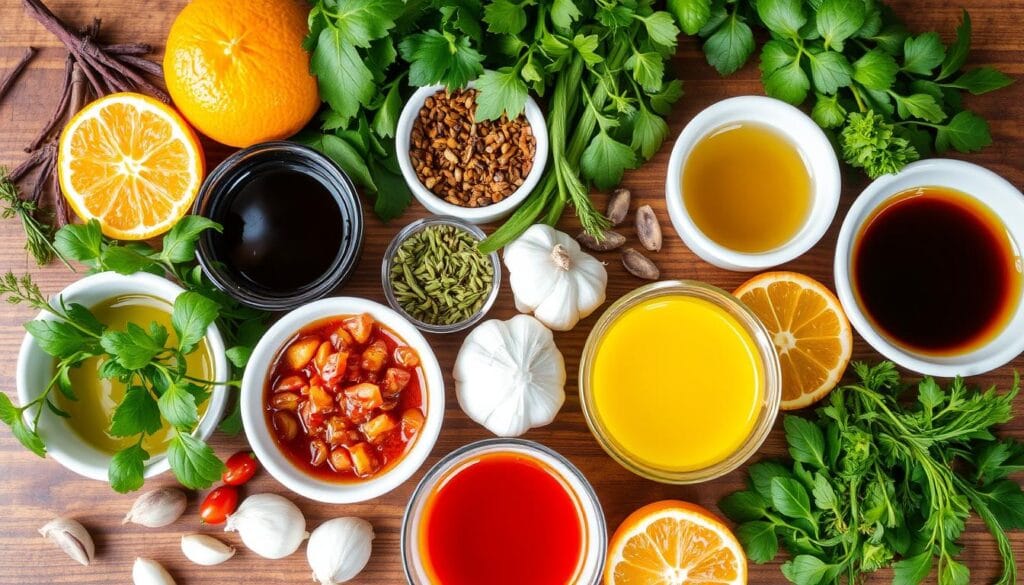
- Classic Herb Blend: Rosemary, thyme, and sage
- Spicy Cajun Kick: Cayenne, paprika, and garlic
- Asian-Inspired Fusion: Ginger, soy sauce, and sesame
- Mediterranean Infusion: Olive oil, lemon, and oregano
“A well-crafted turkey injection marinade is like a flavor symphony, where each ingredient plays a crucial role in creating culinary harmony.” – Culinary Expert
Want to get good at injecting turkey brine? Start with a basic recipe that you can tweak:
| Ingredient | Quantity | Purpose |
|---|---|---|
| Chicken Stock | 1 cup | Liquid Base |
| Melted Butter | 1/4 cup | Fat Content |
| Kosher Salt | 2 tbsp | Seasoning |
| Fresh Herbs | 2 tbsp | Flavor Enhancement |
Pro tip: Don’t be afraid to try new things with your turkey injection marinade. Remember, the key is balance and complementary flavors. Begin with small batches to find your perfect mix before the big day.
Safety Measures and Food Handling Guidelines
Keeping food safe is key when you’re injecting turkey marinade. The right steps can protect you and your guests from foodborne illnesses. Using the correct methods for injecting poultry marinade is crucial.
Temperature Safety Rules
Temperature control is where food safety begins. Here are the key rules for injecting turkey marinade:
- Keep raw turkey refrigerated at 40°F or below
- Thaw turkey in the refrigerator, never at room temperature
- Use a reliable meat thermometer to check internal temperature
- Cook turkey to a minimum internal temperature of 165°F
“Safe cooking temperatures are your best defense against foodborne pathogens.” – Food Safety Experts
Cross-Contamination Prevention
Stopping cross-contamination is vital when injecting poultry marinade. Your kitchen can spread harmful bacteria if not cleaned right.
- Use separate cutting boards for raw meat and other ingredients
- Wash hands thoroughly before and after handling raw turkey
- Sanitize all injection tools and surfaces immediately after use
- Avoid reusing marinades that have contacted raw meat
Remember: Careful preparation ensures a safe and delicious turkey for your meal.
Troubleshooting Turkey Injection Problems
Mastering turkey marinade injection comes with its own set of challenges. Every home chef faces issues when using a turkey marinade injector. Knowing common problems helps you solve them and get a perfectly flavored turkey.
Injecting turkey flavor can lead to several common issues. Let’s look at the most frequent problems and how to fix them:
- Clogged Needle Syndrome
- Uneven Marinade Distribution
- Leakage and Spillage
- Temperature-Related Challenges
Solving Needle Blockages
A blocked turkey marinade injector can ruin your cooking plans. Bits of herbs, spices, or thick marinade parts often block the needle. To avoid this:
- Strain your marinade through a fine-mesh sieve
- Blend it to make it smoother
- Wipe the needle openings clean between injections
“A clean injector is the secret to perfect turkey flavor distribution.” – Professional Chef Recommendation
Uneven marinade distribution can come from bad technique or uneven needle insertion. To improve:
- Insert the needle at the same angle
- Apply slow, steady pressure
- Rotate injection points for better coverage
| Problem | Potential Cause | Solution |
|---|---|---|
| Needle Clogging | Thick marinade ingredients | Strain and blend marinade |
| Leakage | Too much pressure | Lessen pressure, inject in smaller amounts |
| Uneven Distribution | Uneven needle placement | Follow a systematic injection pattern |
By learning these troubleshooting tips, you’ll get better at using your turkey marinade injector. This ensures a deliciously flavored turkey every time.
Storage and Resting Times After Injection
Getting your turkey marinade right is just the start. Storing and resting it properly is key for safety and flavor. These steps will make your turkey tender and delicious, impressing everyone at the table.
Refrigeration Guidelines for Injected Turkey
Right after injecting your turkey, put it in the fridge. It needs to stay at 40°F or below to avoid bacteria. Follow these important steps for safe storage:
- Put the turkey on a clean tray in the fridge’s coldest spot
- Make sure nothing drips on the turkey
- Keep it in a sealed container or wrapped tightly in plastic wrap
Maximum Marination Periods
Timing is crucial with injecting turkey marinade. Too long can make the meat tough and unpleasant.
| Turkey Size | Maximum Marination Time |
|---|---|
| Small Turkey (8-12 lbs) | 12-24 hours |
| Medium Turkey (12-16 lbs) | 24-36 hours |
| Large Turkey (16-20 lbs) | 36-48 hours |
Pre-Cooking Rest Times
Before cooking, let your turkey rest at room temperature for 30-45 minutes. This helps the marinade spread evenly and cooks better.
“Patience in preparation leads to perfection on the plate.” – Professional Chef
Remember, how you store and rest your turkey is just as important as the marinade. Follow these tips for a juicy, flavorful turkey that will be the star of any meal.
Conclusion
Mastering the turkey injection technique can turn a simple holiday meal into a memorable feast. By learning how to inject turkey marinade, you’ll improve your cooking and wow everyone with juicy, flavorful meat.
Starting with a good turkey injector set opens up a world of flavors. Whether it’s for Thanksgiving, a special dinner, or a weekend barbecue, your new skills will make your poultry dishes irresistible.
Remember, practice is key to mastering turkey injection. Begin with easy recipes, try new flavors, and always keep food safety in mind. With time and focus, you’ll become a skilled home chef, making every turkey a hit.
Your turkey injection skills are not just about cooking. They’re an art that blends tradition with creativity. Each injection is a chance to add depth and richness to your cooking, making every dish special.
FAQ
What equipment do I need to inject a turkey marinade?
You’ll need a marinade injector with different needle sizes. Also, a bowl for mixing your marinade and cleaning tools like bottle brushes. Professional sets include stainless steel needles for various meat types and marinade thicknesses.
How far in advance should I inject my turkey before cooking?
Inject your turkey 12-24 hours before cooking for best results. This lets the marinade soak into the meat evenly. Don’t inject more than 24 hours in advance to avoid bacterial growth.
Can I use store-bought marinades for turkey injection?
Yes, you can use store-bought marinades if they’re thin enough for the injector. Many work well, or you can thin them with broth or water. Homemade marinades offer more personalized flavors.
What are the best injection points for maximum flavor?
Focus on the breast, thighs, and drumsticks. Use the needle at different angles for even distribution. Aim for 1-2 inches apart for consistent flavor.
How can I prevent marinade from leaking out of the turkey?
Inject slowly and carefully with gentle pressure. Don’t overfill any spot. Use a marinade that absorbs well into the meat. Pat the turkey dry before injecting and use a sharp needle to avoid skin damage.
Are there any safety concerns with turkey marinade injection?
Always follow food safety: use clean equipment, keep the turkey cold, and cook to 165°F. Clean your injector well and avoid cross-contamination by using separate tools.
Can I inject a frozen turkey?
No, thaw your turkey completely before injecting. A thawed turkey ensures even marinade distribution and avoids food safety issues. Thaw in the fridge for 24 hours for every 4-5 pounds.
How much marinade should I inject into a turkey?
Use about 1/2 to 1 cup of marinade for a 12-14 pound turkey. Spread it evenly by injecting small amounts in several spots. Avoid making the meat soggy or diluting its flavor.

